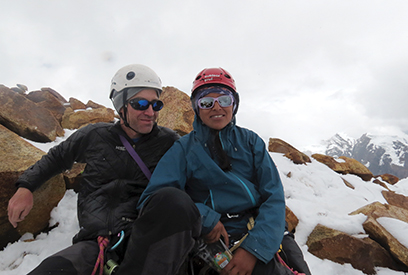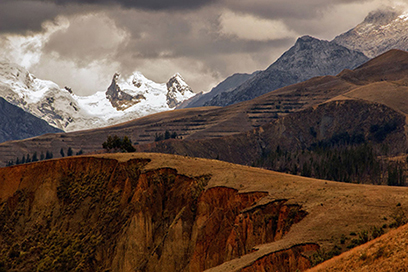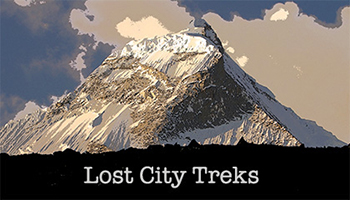
General Packing List for Alpine Treks in Peru
Feet
• Lightweight good quality hiking boots, make sure they are well broken in before the trip (a Goretex liner is not necessary).
• A light weight pair of shoes for camp and town.
• 2 heavier pairs of wool or synthetic socks or whatever is appropriate to your boots for the trek (this may include a light pair of liner socks)
• Three or four pairs of regular socks
Body
• Waterproof/Gortex jacket or waterproof poncho
• Rain pants (not required, but can be useful)
• Three or four (including the one you'll have on) shirts ... t-shirts usually
• Thick synthetic (fleece) jacket or sweater or lightweight down/synthetic jacket
• Synthetic trekking pants- nylon or polyester- the legs don't need to zip off and perhaps a second pair of lightweight pants (any material) for camp
• One synthetic long sleeve shirt
• Lightweight synthetic long underwear (base layer) tops and bottoms
• A pair of lightweight gloves
• Underwear and t-shirts for four or five days (a synthetic t-shirt can be a good idea and women may want a sports bra)
• Shorts/swimsuit
Head
• A warm knit/ski cap
• A hat with a large brim or bill for the sun
• Sunglasses
• Headlamp with extra batteries
Other
• A large daypack (approximately 25-30 liters) big enough for your water bottle, camera, rain gear, and jacket
• A large backpack or durable duffel-type travel bag for the burros/mules to carry
• Toiletries (tooth brush, travel size tooth paste, biodegradable soap, etc.)
• Water bottle (at least 1 liter) or camelback
• A small tube of sunscreen with at least 45 SPF
• Lip balm with sunscreen
• Camera
• Sleeping bag comfortable down to temperatures below freezing (depending on the trek- we can also provide sleeping bags if you do not want to bring one)
• A small lightweight towel for the trek
• Trekking poles (optional)
• Bug repellent in a small non-aerosol bottle or tube
• A book, ebook, or tablet for reading
• You may also want to bring a light-weight pair of binoculars if you like birds
Acclimatization
All of the treks we currently offer go to very high altitudes so proper acclimatization is essential. There are no hard and fast rules, but we suggest at least a couple of days, ideally several, spent living and sleeping above 3000m before you head out on your trek. Everyone acclimatizes at a different rate, so if it is your first experience with high altitude you might want to be a bit conservative and give yourself a little extra time. Some of our treks are desgined to include accil------Eat normally, drink plenty of water, and get some exercise. That being said, it is unusual for someone to leave a trek due to altitude sickness, although the first couple of nights are sometimes a little rough. If you like, we can make a couple of acclimatization days a part of your trek and organize short excursions and hotel for those days.
Insurance
We do not provide insurance, but there are many companies that offer travel insurance that will cover you while you are traveling.

How fit do I need to be?
You don't need to be a world class athlete to trek in Peru. These days there are plenty of folks in their 70s perfectly capable of completing even the more difficult treks. You do need to be able to walk up a moderately steep incline for three or four hours... maybe five in the Huayhuash! Long stiff walks, running, cycling, and climbing stairs are all good workouts to prepare for your trek. If you are concerned about your level of fitness we can talk about it and choose a route that will challenge you, but not destroy you.
What happens if I cannot complete the trek or have an accident?
If you for some reason get sick along the way we have a couple of options: If it's nothing serious you have the option to ride the emergency horse for a day or two and this is by far the most common solution. If you need to leave the trek we will use the same emergency horse to take you to the nearest road, which would rarely be more than a day's ride, and arrange for transportation via satellite. Please understand that you are responsible for any costs incurred in the evacuation, for medical care, and for hotels and food while in town. Evacuation by helicopter is rarely an option anywhere in Peru, but a taxi back to town shouldn't cost more than a couple of hundred dollars. Serious accidents while trekking are very rare, but we are always prepared regardless. Your guide will be a certified Wilderness First Responder with an extensive first aid kit. Medical facilities are good in Cusco and mostly adequate in Huaraz.
Deposits, Payments, and Cancelations
Unless otherwise specified, these are our policies regarding deposits, payments, and cancelations:
We require a 10% deposit to confirm our trips. This deposit is fully refundable minus any transfer/bank fees up to 90 days before trips in Cusco and 60 days before trips in Ancash.
Final Payments are due by at least 60 days before the start date of the trip. Bank tranfers are the best way to pay for your trip, but there are other options. Please contact us for more information.
If you need to cancel your trip for any reason these are our cancelation policies:
31-60 days before start of trip we retain 50% of the full trip cost.
8-30 days before start of trip we retain 75% of the full trip cost.
0-7 days before start of trip we retain 100% of the full trip cost.
Safety in Peru
In general Peru is a reasonably safe place to visit. The crime that exists is generally non-violent and mostly just frustrating. In urban places exercise the same level of caution you would in any big American city, but keeping an eye on your bags a bit more than you might otherwise. Drivers in Peru tend to be bad, but we work only with very responsible people. The treks in Cusco and the Cordillera Blanca are very safe with virtually no crime at all. The Huayhuash has had a history of problems, but there have been no incidents involving tourists in many years. The communities take tourism seriously and have made the route much more secure in recent years.
Cultural Sensitivity
In the course of our adventures we will encounter indigenous people who live lives far from the mainstream of modern urban life. These kind and remarkable folks are some of the world's last humans living a truly sustainable existence. We admire them and of course intend them no harm, but miscommunication is always a possibility. For this reason we discourage taking photos without permission of adults or children we don't know as they go about their day-to-day business. That being said, no one we work with minds having their picture taken. So, careful with the camera lest you risk having a potato thrown at you!

